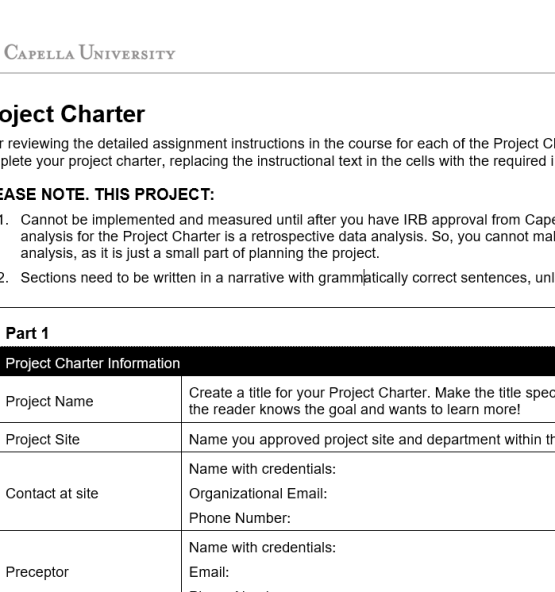


Project Charter
After reviewing the detailed assignment instructions in the course for each of the Project Charter components, use this template to complete your project charter, replacing the instructional text in the cells with the required information.
PLEASE NOTE. THIS PROJECT:
1. Cannot be implemented and measured until after you have IRB approval from Capella and your site if indicated. The gap analysis for the Project Charter is a retrospective data analysis. So, you cannot make your whole project a retrospective data analysis, as it is just a small part of planning the project.
2. Sections need to be written in a narrative with grammatically correct sentences, unless indicated in the specific section.
Availability:In Stock
After reviewing the detailed assignment instructions in the course for each of the Project Charter components, use this template to complete your project charter, replacing the instructional text in the cells with the required information.
Part 1 |
||||||||
| Project Charter Information | ||||||||
| Project Name | Create a title for your Project Charter. Make the title specific and distinct from other projects so the reader knows the goal and wants to learn more! | |||||||
| Project Site | Name you approved project site and department within the site. | |||||||
| Contact at site | Name with credentials:
Organizational Email: Phone Number: |
|||||||
| Preceptor | Name with credentials:
Email: Phone Number: |
|||||||
| Executive Sponsor | Identify this person by role and title (no names) and briefly describe why this person was selected (rationale for the selection). | |||||||
| Gap Analysis | Discuss the current practice for the practice problem, such as the current the policy/procedure or what is currently done. Explain the background and significance of the proposed practice problem with the organization.
Explain how you identified the “gap” or opportunity for change. Provide empirical and contextual evidence to support the gap, need, or improvement. National data and internal data at YOUR research site. This needs to be very specific and actual data. Describe the desired condition. Include your Gap Analysis tool as an appendix to this document (examples includes RCA, Fishbone, DMAIC). |
|||||||
| Evidence to Support the Need | Consider primary and secondary data sources, regulatory requirements, clinical practice guidelines, and benchmarking data to support your proposed intervention or practice change. Include 3-4 citations (published within the last five years) that substantiate the gap or problem exists and why improvement is needed. The citations need to support your proposed change in practice. | |||||||
| PICOT | Develop a problem statement (1-2 sentences): Current state, identified problem/gap and the desired or expected state. | |||||||
| Project Aim | Describe the overarching aim (goal/outcome) of the project, including the goals, the anticipated impact on the population/system/organization, why you are addressing it (importance/relevance) and pertinent background or historical information. | |||||||
Part II |
||||||||
| Stakeholders | ||||||||
| Stakeholder | Identify the key stakeholders for your project. Think of key stakeholders (internal and external). This might include patients/clients, families, community leaders and organizations, health agencies, systems within the organization etc. List between 3-4 potential stakeholder members | |||||||
| Initials or ficitious name | Title, Role or Affiliation. | Connection to the project. | Potential impact (how affected). | Contribution to the project. | Barriers or anticipated challenges if any | |||
| Team Leader | Identify the team leader by initials and/or fictitious name and primary role within the organization. Be sure to complete the interactive media in Week X before completing this section. Include the following:
· Why you selected this person to lead the team. · Useful qualities this leader might leverage for success (consider emotional intelligence and communication/collaboration attributes). · Discuss how an effective leader in this context might address ethical practices, diversity, equity, and inclusion in leading the team and the quality improvement effort. · Leadership style(s) or approach(es) to be utilized. · Identify two different leadership approaches that might be utilized to lead the team. Briefly describe the approaches using 1-2 citations/references (published within the last five years) for support. · Explain why you selected these two approaches. · Think about your own experience and leaders that have been most effective. Assess when different situations might necessitate different approaches in developing and implementing your Project Charter. Provide an example of how the leader might utilize each of the approaches you selected in practice.
|
|||||||
| Team Members | Identify 4-6 team members (initials or fictitious name), department or affiliation and credentials or qualifications. Think about how a diverse set of individuals (demographics, disciplines, experiences, knowledge) will add to the team!
Describe each team member’s title, department or affiliation, qualifications/credentials and the rationale for inclusion and how the person contributes to the project’s success. |
|||||||
| Title | Department or Affiliation | Credentials or Qualifications | Rationale for selection/Contribution to the project | |||||
| Communication Plan | ||||||||
| Develop a communication plan for each person associated with the Project Charter, e.g., Executive Sponsor, Stakeholders, Team Leader, Team members. | ||||||||
Reviews
There are no reviews yet.